

ISSN: 2833-4752 (Digital)
ISSN: 2833-4744 (Print)




ISSN: 2833-4752 (Digital)
ISSN: 2833-4744 (Print)

A2Q (America to Qatar) is a digital magazine that spans the work of artists and the insights of experts from the United States, Qatar, and the Arab and Islamic worlds. As a digital platform serving creatives with diverse perspectives in art and culture, A2Q addresses subject matter in the aim of bridging cultural barriers and cultivating understanding. While at its core A2Q provides a voice to culture, history, and art relating to the Arab and Islamic communities around the world, A2Q also exists in recognition of the universal appeal of creative expression and the benefits of cultural convergence.

Interested in being featured in an upcoming issue of A2Q? You can submit your work as an artist, writer, or academic with the QAIC editorial team for a chance to be featured. If selected, we will contact you to begin the editorial process. More information can be found at www.qataramerica.org/A2Q.
The Qatar America Institute for Culture (QAIC) is an independent 501(c)(3) non-profit organization that creates, curates, and executes programs and research that amplify the prominence of all forms of art and culture in society. QAIC cultivates artistic expression and cultural dialogue from the United States, Qatar, and the larger Arab and Islamic worlds.

QAIC serves as a vital hub to convene artists, curators, storytellers, creatives, scholars, and academics, connecting them with a global network that extends beyond its physical space in Washington DC. Through art exhibitions, educational programs, scholarly research, and cross-cultural partnerships, QAIC provides interactive experiences in an inclusive environment to celebrate and appreciate art and culture.
To learn more about QAIC, please visit our website at www.qataramerica.org
Fatima Aldosari
Nada Darwish
Laila Jadalla
Lyndsey Medlin
Caroline Scullin
Doha Film Institute
Nada Ammagui
Marissa Arciola
Nicoletta Fazio
Abdelrahman Kamel
Alyaa Al-Maadeed
Albert Ting
DotLemon
Qatar Museums
Syrian Music Preservation Initiative
Andrew Abell
The Doha Film Institute SPECIAL THANKS
QAIC’s headquarters, located in DC’s popular Dupont Circle neighborhood, hosts rotating exhibitions throughout the year in our historic gallery space. Whether an innovative contemporary art installation or a sensory journey through history, these exhibitions invite visitors of all ages to explore diverse forms of art and heritage.
At QAIC, all are welcome to expand their knowledge of the arts and culture by participating in our regular educational programs. Our Expressions Art & Culture Talks provide audiences exclusive insight from creatives and experts on topics including horse breeding, film, and architecture. The newly launched Museum Series convenes museum practitioners not only for a behindthe-scenes look at today’s museums, but also to generate dialogue about current museological trends and issues. At our hands on cultural enrichment events, audiences learn about art, culture, and the creative process by producing their own art and crafts.
We invite members from our various communities to engage with us in many ways, whether through celebrations such as our iftar dinners or our annual IMPART Summit, the “Congress for Creatives.” We also offer various scholarly opportunities, including fellowships and internships, throughout the year for those interested to get further involved with QAIC.




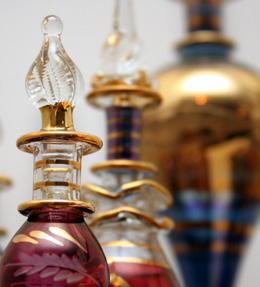

We are proud to bring you another issue of A2Q Magazine, in which we include a multitude of themes and topics that highlight the year 2022. For this volume, we are shifting away from a definitive theme to reflect on a diversity of topics. We particularly reflect on some of our favorite inspiring moments of 2022 with a combination of articles that celebrate cultural diversity and art in sporting events and aspiring award-winning Qatari filmmakers, and the ties the US and Qatari landscape and culture share. Our hope is that these articles, written by QAIC Fellows, guest writers and partners shed light on the initiatives and perspectives that open a world of possibilities for anyone who seeks to engage with the multifaceted ways culture shapes our lives. My gratitude to our contributing writers, QAIC’s colleagues, fellows, partners, and scholars, such as Alyaa Al-Maadeed, Nada Ammagui, Marissa Arciola, Nicoletta Fazio, Abdelrahman Kamel, and the Doha Film Institute.
This year marked the FIFA World Cup Qatar 2022™ tournament which brought a wonderful celebration of sports and culture and bridged relationships between the East and West. A historical mega event, brought for the first time to an Arab country, which reminded us that as we celebrate sports, we also celebrate our cultural differences and how they can help bring us closer together as a global community. Our “Art of Athletics Festival” highlighted the art and cultural dimensions of the FIFA World Cup Qatar 2022™ to our community in Washington D.C., which included exhibition of the official FIFA World Cup Qatar 2022™ posters designed by Qatari artist Bouthayna Al-Muftah.

As this year draws to a close, I would like to extend my warmest wishes to you and your loved ones for a joyous holiday season and a prosperous new year. Reflecting on our programming throughout this year, we cannot help but think of our members and partners who supported our vision and contributed to where we are today. 2022 was particularly a special year for QAIC as we celebrated the theme of “Sustainability in the Arts” in our FOCI Photography and IMPART Artist Grant open calls, a new QAIC Cares partnership with Common Good City Farm, and a host of panels at our IMPART Summit: Congress for Creatives. Our network of growing partnerships with cultural leaders both in Qatar and the U.S., and our diverse and global community of members is a testament to the value and need for platforms of cultural exchange such as ours. Through our work we hope to extend the conversation on intercultural dialogue by further expanding our increasingly diverse and global community.
Finally, I would like to offer my gratitude to the QAIC team, our partners, and our sponsors, who made this year such an incredible experience both in Washington D.C. and in Doha. We are truly grateful for your continued support of our work and cannot wait to show you what we have in store for next year. If you would like to learn more about QAIC’s 2022 programs, please keep an eye out for our Year in Review report which highlights many of our programming and events throughout the year and our vision for 2023 in January. QAIC will continue to evolve and grow, featuring exhibitions and program content that is reflective of our mission. Here’s to a bright 2023 and all the opportunities it will bring.
With gratitude,
 Fatima Al-Dosari, Executive Director
Fatima Al-Dosari, Executive Director

Our most recent exhibition, Cultural Crossings: Exchanges Beyond the Silk Road, opened for visitors to enjoy and participate alongside QAIC’s programming and concert on September 10th. Cultural Crossings is QAIC’s flagship program that aims to celebrate the transmission of culture along the Silk Road routes and highlight the living cultural traditions that continue to be expressed around the world today. Historically, the Arabian Gulf sat at the crossroads of both land and maritime trade routes, dating to the earliest iterations of the infamous Silk Road over 2,000 years ago. This exhibition highlights the overall legacy of this network as it brought more than just physical materials – it also allowed the transfer of ideas, religion, knowledge, and a multitude of numerous other aspects that make up the modern-day culture of the regions
Thanks to our partners and musical artists Samer Ali, Marissa Arciola, Nezih Antakli, and Maestro Dalal from the Syrian Music Preservation Initiative (SMPI), QAIC held a mini concert with the focal point being Maestro Dalal on the oud. When the concert ended, guests toured Cultural Crossings and QAIC’s Perfumery Museum. After touring exhibits, guests made their way to our ballroom to enjoy traditional Arabic cuisine prepared by The Migrant Kitchen which represents a migration of taste and technique from the Middle East to Latin America.
Guests watch a performance by the Syrian Music Preservation Initiative during the opening reception of Cultural Crossings: Exchanges Beyond the Silk Road at QAIC.


Coinciding with our open house on September 16th, QAIC hosted the official opening reception for the 2021 IMPART Artist Grant awardees’ exhibition showcasing their artwork at QAIC’s headquarters. IMPART is a platform created to celebrate the impact of QAIC’s art and cultural programs in our local and international communities. The 2021 awardees are artist and writer Nia Alexander Campbell, calligrapher and craftsman Josh Berer, and multidisciplinary artist Patricia Daher.
In celebration of Qatar Week, on September 20th, members of the QAIC team attended an exhibition viewing the official FIFA World Cup Qatar 2022™ Poster designed by VCUarts Qatar alumna Bouthayna Al Muftah. Following the exhibition, a panel discussion on Qatari women’s involvement in the FIFA World Cup Qatar 2022™ event was moderated by Qatar University Dean Amir Berbić, Ph.D.
In addition, the QAIC team had the pleasure of visiting VCUarts Qatar’s innovative Research Labs exhibition, held at the Anderson Gallery in Richmond, VA. The Research Labs comprise collaborative groups of faculty, alumni, and students that feature eleven distinct research areas as part of an annual exhibition exchange with VCUarts in the Qatar Campus. Some areas of research explore a broad and diverse spectrum of territories, including cultural production, nanotechnology and textiles, sound design, art and law in the Persian Gulf, product design, pedagogy, and emergent technology. QAIC is pleased to kick off our 2023 programs and exhibitions celebrating Technology and the Arts by bringing the Research Labs exhibition to our headquarters this January.
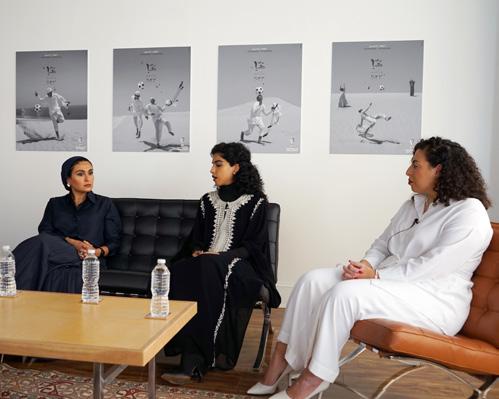
On September 16th, QAIC hosted Indira Gumarova and her organization the Diplomacy and Fashion Project for a special viewing of her Emmy-winning documentary, “The Pins of Madeline Albright.” After the screening, Gumarova participated in a Q&A with the audience and discussed the first-ever Madeleine Award, its meaning, and this year’s recipient, the late Madeleine Albright, former US Secretary of State.
After Gumarova’s documentary, QAIC shifted its attention to the Arab Film House for a screening of the most recent Expressions Artist Talk with fashion designer and QAIC honorary trustee Naeem Khan.


In honor of the 10th Turkish Cultural Heritage Month, QAIC hosted the Turkish Coffee Lady Foundation (TCLF) and the American Association of Washington D.C. (ATA-DC) on October 21st to screen the documentary “Turkish Coffee Tales of Anatolia”.
The documentary takes overs on a coffee journey through Turkey and highlights the historical and contemporary preparations of Turkish Coffee around the country. Among the types of coffee and stops on the film are “dibek coffee” in Mardin, “mirra coffee” in Sanliurfa, “menengiç coffee” in Gaziantep, “saffron coffee” in Karabük, “coffee brewed on ash” in Nevşehir, “coffee brewed on sand” in Ankara, “mastic gum coffee” in Izmir and “traditional coffee” in Istanbul.
The event also featured an extraordinary live demonstration from micro art master Hasan Kale with Turkish coffee and dessert tasting session as well as coffee cup readings.
On Friday, December 16, QAIC hosted its final Film Friday of 2022, screening two very special films. The first, a documentary by Dr. Khalid Al Jaber, celebrates the 50th anniversary of US-Qatar relations and looks at the history of the mutual partnership. The second screened film, “And Then They Burn the Sea” by Qatari filmmaker Majid Al-Remaihi, has the distinction of being the first Qatari film in consideration for an Academy Award nomination. The film has also been shortlisted for an IDA Award and won the Silver Tanit Award at the Carthage Film Festival.
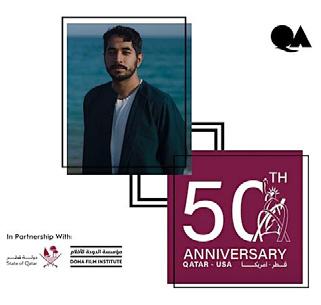
In honor of H.E. Sheikh Meshal Bin Hamad Al Thani, QAIC, held its first Ambassador Salon Dinner on October 11th to celebrate our flagship program Cultural Crossings: Exchanges Beyond the Silk Road.
The salon dinner featured traditional Qatari cuisine prepared by celebrated chef Noof Al Marri and her team. The dinner program began with opening remarks by QAIC’s Executive Director Fatima Al-Dosari, His Excellency Ambassador Al-Thani and Chef Noof. Dinner guests were treated to a live musical performance by the New York Arabic Orchestra illustrating the sounds of the qanun and oud played by Firas Zreik and April Centrone. Following the performance, Qatar Airways Vice President of Sales, Craig Thomas delivered remarks announcing the winner of a grand prize raffle ticket to a FIFA World Cup Qatar 2022™ match including two roundtrip tickets and accommodation. Guests included H.E. Ambassador Jasem Albudaiwi of Kuwait, representatives from QAIC sponsors Qatar Airways, ExxonMobil and Y-International, representatives from various Smithsonian institutions, including the National Museum of Asian Art, the National Gallery of Art, the U.S. State Department and other cultural institutions.

QAIC was pleased to participate as a member of the leadership committee for the Diplomacy and Fashion Project’s Inaugural First Fashion Gala, celebrating the First Lady/Gentleman Fashion at the Conrad Hotel on Wednesday, October 12th, 2022. The gala, which was attended by more than 200 guests including Ambassadors, their families and other country representatives, featured a fashion show of first ladies and gentlemen from 27 countries across the world who have embassies in Washington, DC. Haya Al Adsani, founder and creative director of the Qatari couture label Harlienz represented Qatar with two replica designs worn by Her Highness Sheika Moza bint Nasser Al-Misnad at two public appearances in Doha in 2020 and 2021.
At the fashion show, QAIC Executive Director, Fatima Al-Dosari, also wore a design from Harlienz by Haya Al Adsani, accompanied with modern Arabic jewelry, a luxury handbag and footwear all designed by Qatari designers.

On October 13th QAIC had the pleasure of joining the DC Embassy Chef Challenge at the Smithsonian American Art Museum, representing Qatari cuisine alongside Chef Noof Al Marri and her team from Doha. As part of the International City Food Festival in DC, the DC Embassy Chef Challenge hosted chefs and embassies from all over the world to compete in a friendly culinary competition. The ticketed event allowed the public to taste the chef’s creations and vote for the ones they enjoyed the most. Chef Noof Al Marri and her team delivered three traditional dishes and fiercely fought among 40 other top chefs from their respective countries.


QAIC had the pleasure of hosting guests of His Excellency Ambassador Al-Thani for an intimate dinner as part of the 53rd annual Meridian Ball. Guests were treated to a display of the official FIFA World Cup Qatar 2022™ model stadiums, tours of QAIC’s Perfumery Museum and exhibition, Cultural Crossings: Exchanges by the Silk Road by QAIC’s Executive Director Fatima Al-Dosari, followed by an intimate dinner.
On Saturday, November 12, QAIC welcomed back our Cultural Crossings partners, the Syrian Music Preservation Initiative, for a special workshop featuring Maestro Qadri Dalal discussing the four specially loaned Syrian ouds. Maestro spoke on the history of the instruments, as well as their physical and musical differences. Audiences received an inside look at the craftsmanship of the Aleppo and Damascus luthiers, and heard wonderful musical demonstrations played by the Maestro.

On November 21st and 29th QAIC our second annual Art of Athletics Festival, highlighting the art and cultural dimensions of the FIFA World Cup Qatar 2022™. Guests gathered in the ballroom to watch the US Men’s National Soccer Team play Wales and Iran while enjoying our make-shift café and majlis seating area and eating traditional Arabic match day food and drink —Manakeesh and Karak. Guests also had the opportunity view an exhibition of the Official FIFA World Cup Qatar 2022™ posters designed by Qatari artist Bouthayna Al Muftah, see models of the eight state-ofthe-art World Cup Qatar stadiums, take photos with the World Cup Qatar mascot and other props and more.

On December 6, QAIC took its scent experience to the Library of Congress for a celebration of Qatar National Day hosted by the Embassy of the State of Qatar in Washington, D.C. The evening introduced guests to QAIC’s Perfumery Museum and programs through interactive elements, video, artwork and QAIC’s digital magazine, A2Q. Other organizations with a relationship to Qatar in attendance included Qatar Foundation International, Qatar Airways and more.
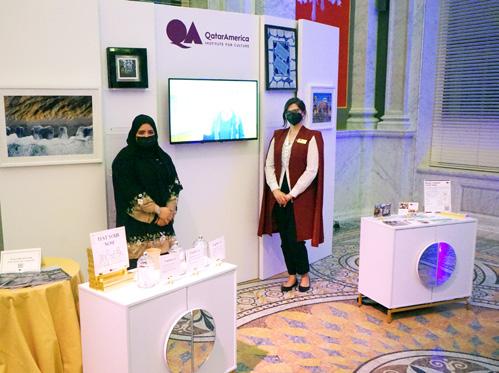
On December 9, 10 and 11, QAIC hosted its second annual IMPART Summit: Congress for Creatives. The culmination of QAIC’s yearlong focus on sustainability in the arts, the Summit began with a private gala celebrating the food and culture of Qatar. Guests were treated to a Qatari-inspired food and décor, and a special performance by celebrated Syrian American pianist and composer Malek Jandali who played scores from his newly released Desert Rose Symphony.
On Saturday and Sunday, our doors opened to the public for two full days of programing. Day one featured engaging panels featuring our 2021 IMPART Artist Grant Awardees, a conversation on sustainability in scent making organized in partnership with the Institute for Art and Olfaction, and the relationship between sustainability, coffee and food culture across the Middle East and North Africa, an art souq featuring goods from DC area ethical fashion shop This is Tribute’s Slow Down Market. Day two featured the films and an introduction by of the three awardees of this year’s Arab Film House Award organized in partnership with the Doha Film Institue. Spiritual artist Aida Murad and DJ Farouq treated guests to a live art party.


Let’s shine a light on exactly what all that means! The Silk Road, simply put, are the numerous trade routes connecting Asia to Europe dating back to the 2nd century BC. These include both land and maritime routes and encompasses a staggering 40+ countries (as defined by modern borders). All these countries today still feel the impact of these trade routes on their cultural traditions, and it is this living (and shared!) heritage that we celebrate with Cultural Crossings.
The Silk Road is so named because silk textiles produced in China were a preeminent commodity that was traded out of China. Spices were another highly prized good coming out of the Indian subcontinent and Arabia. It was after the Roman conquest of Egypt that these preexisting trade routes grew to an enormous scale and became the Silk Road as scholars know it today. Wealthy citizens of the empire demanded exotic luxury goods, and intercontinental trade became organized, formalized, and protected.
Wherever people may go, their traditions accompany them, and travelling musicians brought the music and instruments of their culture with them. The growth of trade routes led to more settlements , places where travelers could rest and restock, along the routes. Travelling musicians earned their livelihood playing at inns and lodging houses, and thus elements of their cultures spread. Along trade routes, instruments were shared and evolved. For instance, the barbat, ancestor of the Middle Eastern oud and European lute, shares similarities to the Chinese pipa.
Road.
Cultural Crossings was spawned out of the idea that such transitory heritage practices unite Silk Road countries through shared aspects of history despite modern borders. Every year, this program will return highlighting a new aspect of cultural heritage, inviting QAIC visitors and guests to contemplate on the inherent interconnectivity that we may have never realized we share.
"
Cultural Crossings: Exchanges Beyond the Silk Road is QAIC’s flagship program that aims to celebrate the transmission of culture along the Silk Road routes and highlight the living cultural traditions that continue to be expressed around the world today.Visitors look at the didactic materials and instruments on display in the exhibition Cultural Crossings: Exchanges Beyond the Silk



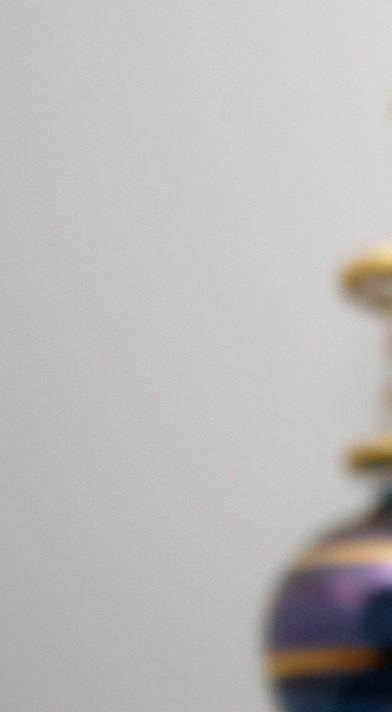


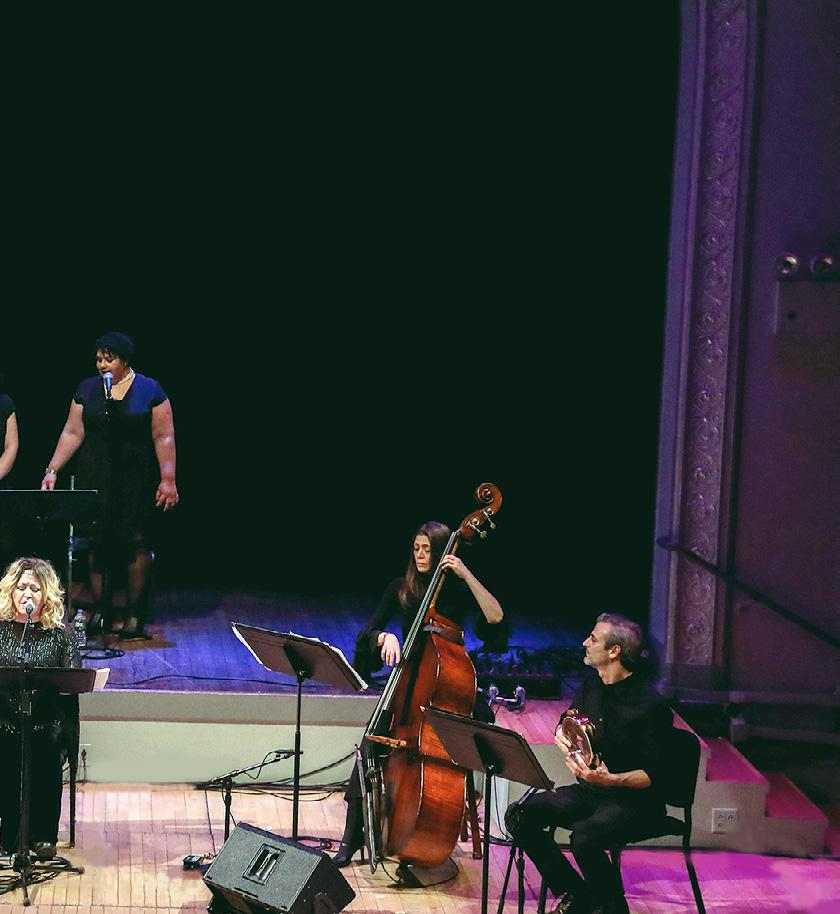
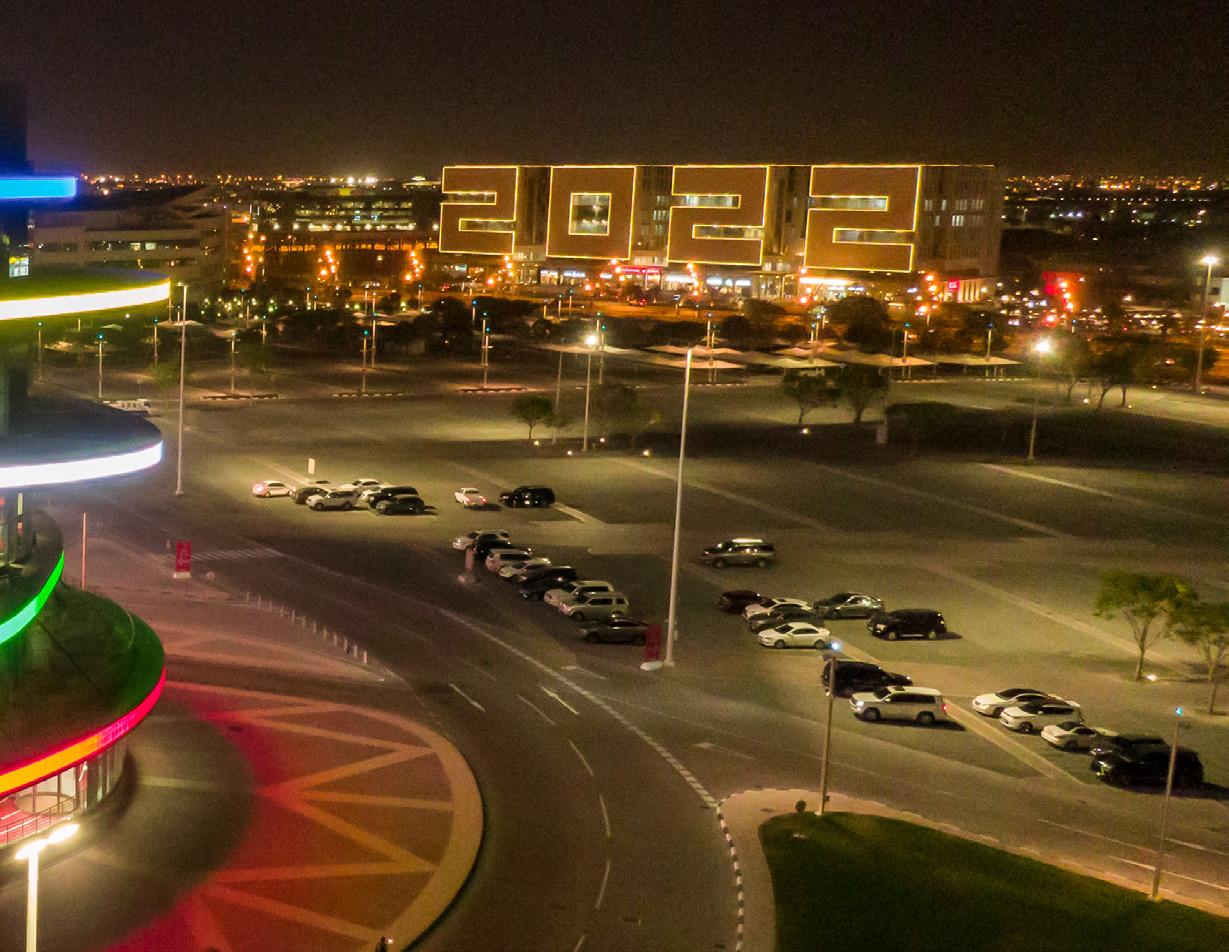


Fig. 2
Small tree-shaped ornament Afghanistan Ghaznavid or Ghurid period, 4th-6th century AH (10th-12th century CE)
Hammered, repoussé and gem-set gold and silver Museum of Islamic Art, JE.81.2002
Fig. 1
Tree ornament Western Asia c. 1st millennium BCE
Twisted gold Museum of Islamic Art, QM.2021.1263
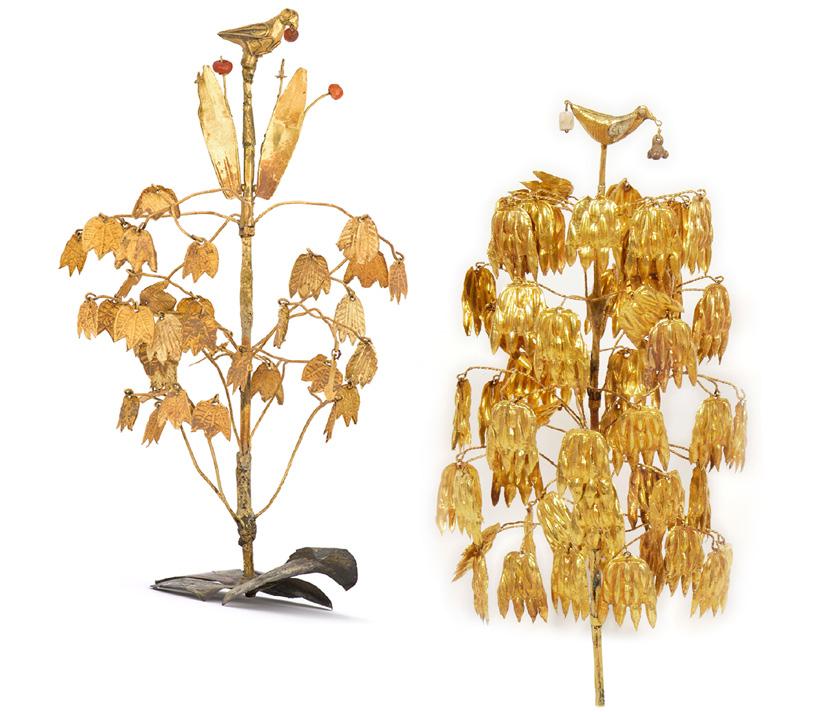
In September 2013, in the very heart of Central Asia, Chinese leader Xi Jinping launched the socalled One Belt One Road, a global infrastructure development strategy to bring Chinese investments in nearly 150 countries and international partners. The initiative, welcome with both enthusiasm and concern, has often been dubbed in Western media as Silk Road 2.0, a shorthand feeding collective imagination with romantic images of a world long gone. While the history of the Silk Road goes back to a good two millennia, the term itself is a modern invention, coined in 1877 CE by the German geographer Baron Ferdinand von Richthofen (uncle to the much more famous WWI flying ace Manfred von Richthofen, AKA the Red Baron). Though no historical source bears mention of the ‘Silk Road’ specifically, the expression refers to an ancient network of overland trade routes that connected the Eurasian continent up until the 18th century CE.
While we have no actual documentation of the volume of trade conducted along the Silk Road, and opinions diverge among scholars, the analysis of both archaeological finds and historical records shows that trade was well in place, connecting the oasis of Central Asia with rich marketplaces east- and westwards. The routes forming the Silk Road facilitated, not without risks, the movement of men and goods, exotic products, new technologies, revolutionary ideas and beliefs. Along the same paths also came armies, deadly inventions, and diseases. A world that was in fact globalized way before modern globalization happened. And a world in which symbols and meanings vastly migrated, travelling through space, surviving the test of time. It is the case of a 3000-year-old golden tree topped by a bird, probably representing an ancient symbol of
rebirth popular among the nomads of Central Asia, replicated into a delicate personal ornament two millennia after (figs 1-2).
The term ‘Silk Road’ might be misleading as it suggests that the main good traded along its routes was silk. Silk represented indeed only a fraction of the goods exchanged but still holds in popular narratives a strong, evocative power. Plain silk in tight bolts, light and easy to carry, was often used as currency; beautifully patterned textiles were carried as gifts by diplomats or locally traded by rich merchants. With the end of the Chinese monopoly of silk production by the 6th century CE, new actors came prominently onto the stage, the Sogdians. A resourceful community of mostly merchants and farmers from the city-states of Central Asia, the Sogdians have recently been labelled by scholars as the ‘influencers on the Silk Roads’. And rightly so, considering the extent of their commercial network, tying together Iran to imperial China and beyond. This sort of Frankenstein shirt (fig. 3), made of a series of silk fragments, showcases some of the most fashionable textiles that the Sogdians produced, wore, and traded: supple and shiny textiles decorated with confronted animals in a ring of pearl. Such patterns, combining motifs from ancient, pre-Islamic Iran with Central Asian symbols gained huge popularity among elites from the Mediterranean to Japan, sparking also local manufactures between the 7th and the 9th centuries CE, the period to which most of these clothes date. Despite the lack of documentary sources, the material culture of the time accounts for the distinctive mark that the Sogdians, today almost forgotten in the folds of history, left on the artistic heritage of Eurasia.
The routes forming the Silk Road facilitated, not without risks, the movement of men and goods, exotic products, new technologies, revolutionary ideas and beliefs... A world that was in fact globalized way before modern globalization happened. And a world in which symbols and meanings vastly migrated, travelling through space, surviving the test of time.
Fig. 3
Silk tunic or shirt

Central Asia, Sogdiana or Tarim Basin
Abbasid period, 2nd-3rd century AH (8th-9th century CE)
Silk samite Museum of Islamic Art, TE.231.2012
Fig. 4
Cup Iraq or Iran
Abbasid or Buyid period, 3rd-4th century AH (9th-10th century CE)
Free blown glass with wheelcut decoration Museum of Islamic Art, GL.19.1999
Fig. 5
Ewer (‘Yue ware’ ceramic)

China, Zhejiang province
Five Dynasties or early Northern Song period, 4th century AH (10th century CE)
Incised stoneware under celadon glaze (partially lost)
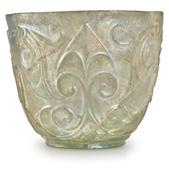
Museum of Islamic Art, PJM.2013.1.2062.1
Fig. 6
The Constellation of Pegasus
From a manuscript of the Kitab suwar alkawakib al-thabita (The Book of Fixed Stars)

Written by al-Sufi (d. 376 AH / 986 CE)
Copied by ‘Ali ibn ‘Abd al-Jalil ibn ‘Ali ibn Muhammad
Iraq, Baghdad
Buyid period, dated Muharram-Safar 519 AH (February-March 1125 CE)
Ink, opaque watercolour and gold on paper Museum of Islamic Art, MS.2.1998
This was a crucial moment for the history of the Silk Road, as it saw the rise and consolidation of Islam in West Asia and the expansion of Chinese Tang power westwards. Ancient systems collapsed as new sociocultural structures emerged.
This was a crucial moment for the history of the Silk Road, as it saw the rise and consolidation of Islam in West Asia and the expansion of Chinese Tang power westwards. Ancient systems collapsed as new sociocultural structures emerged. The newly established capital of the Abbasid caliphate, Baghdad (founded in 762 CE), raised to become one of the largest megacities in history, a think tank of intellectual and artistic talents, and the major commercial hub of its time. Glassware produced between Iran and Iraq reached China and Japan and were coveted goods in Southeast Asia (fig. 4), while Chinese porcelain found a profitable market among Abbasid elites (fig. 5). The battle for the control of Central Asia between the Abbasid forces and the Tang armies lead not only to the progressive collapse of Tang power in China from 751 CE onwards, but to a much more fortuitous, yet revolutionary, consequence: the diffusion of paper outside China. The introduction of paper and its use in the Islamic world sustained the incredible production of scholarship that distinguished the first centuries of the Abbasid history and so strongly informed the development of sciences in the Islamic world as well as in medieval and Renaissance Europe (the westmost end of the Silk Road trade, fig. 6).
Changes in the socio-economic structures of medieval Europe brought merchants, diplomats, and missionaries to walk the dusty pathways of Asia, getting a first-hand experience of a population, whose name and reputation stirred fear and panic: the Mongols. After an almost unstoppable ride across Asia, the Mongol hordes controlled the largest empire in history, stretching from the Pacific Ocean to the Black Sea. Their highly organised rule over such a vast area brought
the so-called “Pax Mongolica”, a period of relative peace, during which it was said that a virgin could walk from Russia to China with a pot of gold on her head without fearing harm. Embassies were exchanges; as political relations greatly increased so trade did with new goods flooding international markets, fashioning personal tastes and collective identities. European medieval inventories of the time list certain fabrics as panni tartarici, indicating luxury textiles made during the Mongol era across Asia, from the Yuan China to Mamluk Egypt. Known as nasij (cloth of gold), these were the most exclusive and exuberant textiles available, heavily decorated with metallic threads (gold and silver), made for the highest members of the Mongol ruling elite. This oversize female ceremonial robe (fig. 7) was once completely covered in gold threads and must have made quite an impression when worn, dazzling its onlookers. Accounts of medieval travellers indeed report the riches of the Mongol courts from Iran to China.
After the fatal blow given by the Black Death in Asia and Europe between 1346 and 1353 CE, political changes and new socio-economic orders caused a progressive decline of the commercial routes of the Silk Road. For centuries, the Silk Road was not only a complex system of routes connecting points on a map. It was, above all, an immense learning gateway to other cultures, truly informing the history of mankind. New routes were now opened westwards, on top of ocean waves, to change the course of history once again.
A new world, exciting yet no less violent, was about to see the light.
Fig. 7
Female ceremonial robe Central Asia

Ilkhanid period, 7th-8th century AH (13th-14th century CE)
Silk, compound twill Museum of Islamic Art, CO.159.2002
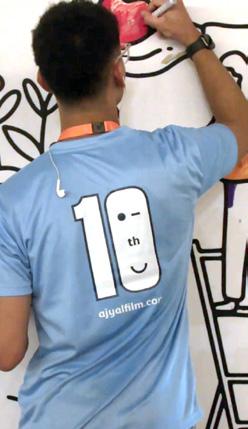







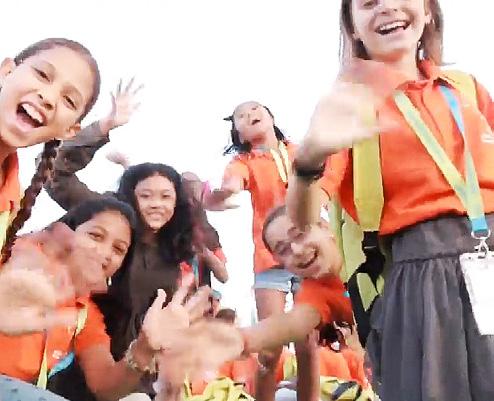
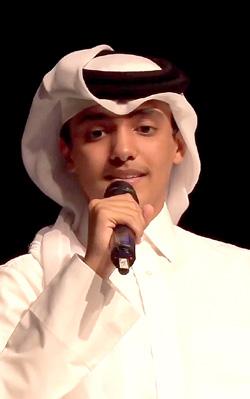
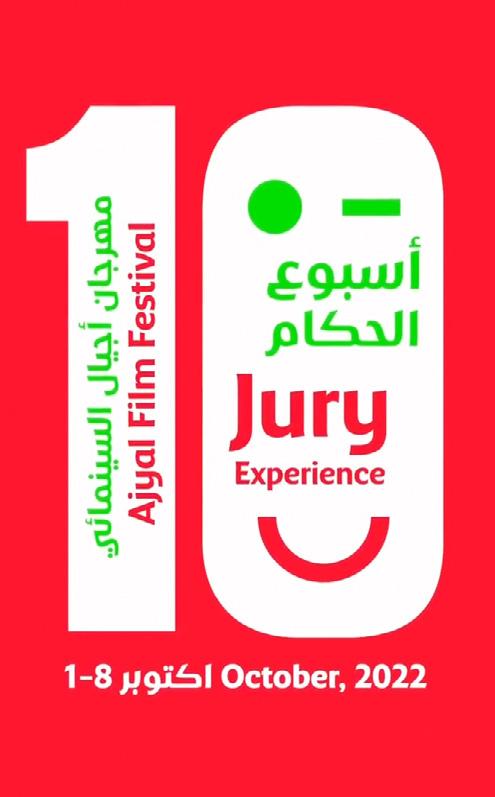
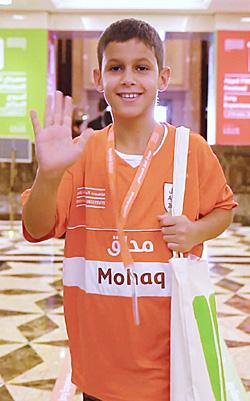

Ajyal Film Festival marked its Special 10th Anniversary edition in 2022 as Qatar’s youth and community driven festival showcasing outstanding homegrown and global independent voices in cinema.
BY THE DOHA FILM INSTITUTETen years ago, when the Doha Film Institute launched the Ajyal Film Festival, an annual showcase of independent films from around the world, it was not only a distinctive film event but also unprecedented for the region.
Ajyal has been and continues to be a unique event by positioning young people at the heart of the Festival. The concept of juries of 8 to 25-year-olds watching, critiquing, and selecting festival winners is a first for the Arab world, and reflects the ambitious vision of Doha Film Institute to cultivate a thriving cinematic ecosystem in Qatar that serves the region and beyond.
By bringing together young people from different backgrounds and establishing a nurturing space where youth are empowered to expand their perspectives and embrace their creative voice, Ajyal lends a voice to the next generation of global citizens. The festival’s far-reaching positive effect on the very fabric of the country uniquely positions Ajyal as an important contributor to the vital development pillars (economic,
human and social) in Qatar’s success as the regional creative hub for the 21st century. DFI has provided an integral contribution to achieving Qatar’s Vision 2030 of a diversified knowledge-based economy.
On the Institute’s role in building the creative industry in Qatar, Fatma Hassan Alremaihi, Festival Director and CEO, Doha Film Institute, said: “Our main focus has always been on nurturing and empowering a new generation of storytellers, and we are extremely proud that they have become invaluable contributors to a sustainable knowledge-based creative industry in the Middle East region and beyond. Our vision for DFI is inspired by the vision of HE Sheikha Al Mayassa, who has been at the forefront of defining the cultural identity and boundless potential of Qatar – and of the region.”
By holding young people at the heart of the Festival, Doha Film Institute reiterates its commitment to educating, entertaining, and nurturing a new generation of storytellers by exposing them to the
latest trends in international filmmaking, especially the work of young talent. Ajyal Film Festival also provides an unparalleled platform for exciting new filmmakers to develop and showcase their work to the world. Many films, especially those made by filmmakers who call Qatar home, have been made possible through the support of the Institute, and many of them are showcased at Ajyal Film Festival in the prestigious ‘Made in Qatar’ program.
“Ajyal draws on the power of film to inspire collective responsibility in people of all ages to work towards a future where we all thrive together. From generation to generation, Ajyal continues to equip youth with powerful creative tools of self-expression to honour the past, celebrate the present, and navigate the unknowns of the future”, commented Alremaihi.
Ajyal has provided a consistent platform for some of the world’s most promising filmmakers. In the wake of a global pandemic, it maintained the importance

of creative work, and ensured that this work would continue to be shared with audiences. In one of the most challenging times in history, the Festival’s pivot to a hybrid model to showcase independent films served to promote healthy interactions online.
It was a celebration of youth, their positivity and passion for cinema driving one of the most youthful film events in the world – the Special Edition of the 10th Ajyal Film Festival, which witnessed participation from a historic record of over 600 Ajyal Jurors from more than 50 nations.
Alremaihi said, “Now in its 10th year, everyone believes in the mission of the Ajyal Film Festival, and everyone recognizes the great rewards that young people benefit from their participation. During the course of the festival, the young jurors discover new voices in cinema, while also discovering their own creative voices, and learn firsthand how the power of storytelling can serve as the most profound tool for positive change.”

Ajyal draws on the power of film to inspire collective responsibility in people of all ages to work towards a future where we all thrive together.Youth attendees gathered for a discussion (Credit: Ajyal Film Festival Instagram / @ajyalfilm) Fatma Hassan Alremaihi, Chief Executive Officer, Doha Film Institute (Credit: Ajyal Film Festival Instagram / @ajyalfilm)
 BY ABDELRAHMAN KAMEL
BY ABDELRAHMAN KAMEL
Since its inception, Arab culture is characterized by a great connection to spices and perfumes. These perfumes carry within them a touch of local traditions and an attachment to cultural expressions and associations of aromatic fragrances. Perfumery is thus considered an art and there are stories to each scent. With strong cultural ties to scent, Arabic traditions have played an important role in the development of modern and contemporary perfumery. Here we will give a glimpse into QAIC’s Perfumery Museum, which is the fruit of a collaborative effort between QAIC and partners in Doha and beyond to take visitors on
a journey for the senses and provide an introduction to the history, science, and stories behind the craft of perfumery throughout the Middle East.
Spices, resins, exotic woods, herbs, essentials oils and musk are some of the raw materials that Arabic perfumery has traditionally used to create enchanting scents. In addition, flowers and plants such as rose, jasmine or orange blossoms are commonly included in Arabic perfumes. Islamic culture and perfumery are deeply linked to religion. Many Arabian families prepare what is called bakhoor, a kind of incense that
is used to purify their homes. Quite often, families have their own bakhoor scent, a mixture of amber, musk, sugar, and other elements that are then turned into a “paste” that is dried at the sun to form a scent block. The block is divided in smaller pieces and then burned, producing a fume which perfumes the whole room.
These scents are also mentioned in the holy Quran which is an indicator of how deeply attached Islamic culture is to scents and aromas of the region. For instance, in the verse, “its [the Quran] conclusion is musk” is in reference "Its conclusion is musk" in reference to the act of reciting the Quran, the belief is that the end of a recitation should carry the same pleasant smell as musk. So, what other ingredients are used in fine fragrances? Well, the main ingredients are oud, roses, saffron and sandalwood.

Oud which is pronounced [ood] is the heartwood from the Agar tree. Healthy trees have an odorless wood. However, some older trees become infected with fungi thereafter a resin is produced inside the wood. As the infection grows, it results in a very rich dark resin within the heartwood. The resin is distilled, getting the pure oil of oud.
Rose, which is known as [ward] in Arabic, is not only a beautiful flower but also an essential ingredient in fragrances. Damascus Roses only bloom for thirty days each year and the blossoms are still picked individually. The picking is always a race against the sun because as the temperature rises, the blossoms lose their essential oils. Five tons of blossoms are needed to produce one kilogram of oil.
Details of historical perfume bottles on display in QAIC’s Perfumery Museum. Objects courtesy of Reem Abu Issa.

Saffron which is pronounced [ja-fa-raan] in Arabic has got three stigmas, which are dried and used in cooking and in perfumery. Saffron is the most expensive spice by weight and is produced in Iran, Spain, India, Greece, Azerbaijan, Morocco and Italy.
Sandalwood, which is known as [khasab al-sandal] in Arabic, is the wood from the Santalum tree. The sandalwood from Mysore, region of Karnataka, Southern India, is considered to be of the highest quality. Despite 4000 years of existence, the sandalwood essence only appeared in modern perfumery in the last century.
The main feature of Arabic perfumes is its sensuality, exoticism and intense scent. Arabic fragrances are usually more intense and stronger, due to the culture and due to the warm temperatures of the region. Through our museum we hope that visitors can get to learn more about the rich and diverse aromas of the Middle East. The Perfumery Museum is open by appointment by visiting qataramerica.org/ perfumery-museum/ .
Work cited Astrid, Écrit P. Arabic perfumery enchants by its fascinating scents. Euro Fragance, 2016.

The main feature of Arabic perfumes is its sensuality, exoticism and intense scent.
Arabic fragrances are usually more intense and stronger, due to the culture and due to the warm temperatures of the region.BY NADA AMMAGUI


... the National Museum of Qatar, designed by architect Jean Nouvel to emulate the desert rose, expanded the country’s public art program by commissioning dozens of artworks by local and international artists...
While Qatar’s art scene has been thriving for decades — the National Museum of Qatar first opened in 1975 — the expansion in the years since Qatar won the bid to host the FIFA World Cup Qatar 2022™ in 2010 has created a plethora spaces and experiences offered by Qatar Museums (QM), the institution at the helm of the country’s cultural scene, for visitors and residents alike. As Qatar’s Supreme Committee for Delivery & Legacy worked to build stadiums and prepare infrastructure to support the 1.5 million1 anticipated visitors, Qatar Museums was ensuring that football fans had the opportunity to learn about the host country and its history and culture without having to look very hard for it.
In the years leading up to the World Cup, Qatar Museums reopened the National Museum of Qatar, designed by architect Jean Nouvel to emulate the
desert rose, expanded the country’s public art program by commissioning dozens of artworks by local and international artists, and announced new museums to showcase collections of art and objects across various topics. Earlier this year, the 3-2-1 Qatar Olympic and Sports Museum, dedicated to showcasing the history and heritage of sport, was opened adjacent to the Khalifa International Stadium. Additionally, several new museums were announced, to open in the coming years, including the Lusail Museum, which will hold the world’s largest collection of Orientalist art, the Qatar Auto Museum, and the Art Mill, a multi-use creative space.
The artworks displayed in Qatar’s ‘open museum,’ accessible to the public at all times, cover a wide range of themes and are made from a variety of materials,

including stone, steel, resin, wood, and concrete. Famous installations include Urs Fischer’s Untitled (Lamp/Bear), a bright yellow, larger-than-life teddy bear attached to a lamp, that greets visitors upon arrival at Doha’s Hamad International Airport and Damien Hirst’s The Miraculous Journey, commissioned by Qatar Museums, located outside of the Sidra Medical and Research Centre in Doha. Installations by other renowned international artists, including Richard Serra, eL Seed, Monira Al Qadiri, KAWS, Saloua Raouda Choucair, and Jeff Koons, are also on display across Qatar, contributing to the dialogue and cultural exchange promoted by the diversity of artists and ideas on display. Alongside these artists, Qatari creatives have also produced public installations that shed light on local cultural, historical, and social themes, enabling football fans to learn about the country while supporting their favorite teams.
For the Lusail waterfront, Qatari artist Shouq Al Mana has created an installation entitled Egal (2022), depicting the traditional headpiece worn by Qatari men, tiled at an upwards angle as a tribute to her compatriots for their solidarity during the boycott of Qatar imposed by some neighboring countries in June 2017. Al Mana’s installation, consisting of five stainless steel egals, was commissioned by Qatar Museums’ 5/6 Initiative, a competition that provides Qatar-based artists the opportunity to produce public artworks that highlight a sense of unity and community within the country after the blockade. During the World Cup, the egal became a symbol of the country’s hospitality and welcoming spirit as dozens of videos circulated on social media showing Qatari and Gulf citizens helping visitors affix the egal on their heads atop their respective flags.


 Egal by Shouq al Mana. Photography courtesy Qatar Museums. © Qatar Museums 2022.
Egal by Shouq al Mana. Photography courtesy Qatar Museums. © Qatar Museums 2022.
During the World Cup, the egal became a symbol of the country’s hospitality and welcoming spirit...Tawazun by Shua’a Ali located in Msheireb. Photography courtesy Qatar Museums. © Qatar Museums 2022.
Shua’a Ali’s Tawazun (2021), located in Msheireb, a recently built district inspired by local, historical architectural styles in the heart of Doha, was also commissioned by the 5/6 Initiative. Tawazun, which translates to “balance” or “equilibrium” in English, consists of several sculpted and natural stones atop one another, balancing delicately on a cube, which represents an “equilibrium of traditional and modern elements found in Qatar’s infrastructure and heritage.”2 While some stones are left in their natural, rough state, others are smoothed and shaped, formed into floor tile octagons and cement cubes, capturing the balance of natural landscape and built environment in the country. Likewise, the artist’s installation Milestones takes an abstract, material approach to depicting Qatar’s economic history and the evolution from pearl-diving to diverse industries in recent decades.3 The installation consists of three stacked-stone sculptures balancing on cement pedestals and cinder blocks, some wrapped in a golden rope to represent tools used during long months at sea in pearl-diving seasons. Pristine pearls sit atop jagged off-white rocks, reminiscent of sea-side stones, and are stacked onto larger, smooth stones
painted a deep-sea blue. Near them is a sculpture of a gold-painted stone, sitting under a white rock, representing prosperity and the bright future ahead.
At Al Janoub Stadium, contemporary Qatari artist Faraj Daham’s The Ship greets World Cup crowds as they head into the stands. The skeletal ship, made of wood and concrete, is inspired by cave inscriptions found in parts of Qatar’s Jabal Al Jassasiya4 and represents the vessel that enabled locals to fish, dive for pearls, and engage in ocean trade. At the base of the ship, Daham has carved these inscriptions to draw on the history of sea-trade in the region, which connected peoples across lands and sustained local populations for centuries. The bare-boned sculpture strips the country’s seafaring history and historical narratives to their roots, showcasing a simplicity recalling the days of Qatar’s pre-oil economy. At the same time, the concave body of the ship echoes the curves of the stadium behind it, while also highlighting the contrast between the desert landscape and its flowing dunes, and the ebbing waves of the Persian Gulf.

On the sidelines of crowd-drawing football matches, the Qatar World Cup has been an opportunity for the country to showcase its robust cultural scene, ranging from public art installations, museums, galleries, and creative hubs to city-wide murals, and more.
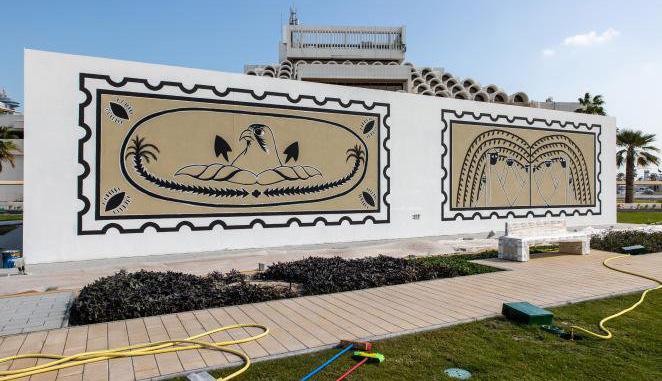

Qatar Museums also supports initiatives to promote the country’s local art scene, including an annual open call for JedariArt, a competition that enables Qatarbased artists to design murals that activate surfaces across the country’s urban landscape. These murals become permanent fixtures in the country’s urban space and inspire conversation between the art and the surrounding neighborhood. Among the dozens of murals commissioned so far, Qatari artist Maryam Al Maadhadi , for instance, designed a mural for Post Office Park near the Qatar Post headquarters along Doha’s corniche. Al Maadhadi’s mural, entitled We Feel Safe in Qatar, features two side-by-side images designed to look like historical stamps in muted, desert tones, drawing on the mural’s location near Doha’s central post office. The stamps depict symbols central to the country’s heritage, such as the date palm and the falcon,5 and draw on themes of safety, cultural heritage, and harmony.6
Qatari muralist and graffiti artist Mubarak Al Malik, whose murals were also showcased at Art Basel in Miami in 2021,7 was also commissioned by JedariArt to showcase his distinctive, colorful style along the streets of his hometown of Doha. Al Malik’s cartoon-like figures can be found across various locations in Doha, including Al Abraj Park and cultural hub Fire Station. Figure of a Woman Wearing Batoola and Holding Mubkhar,6 located at Al Abraj Park, symbolizes the welcoming atmosphere of the country by depicting a Qatari woman donning a traditional golden face covering and holding an incense burner with a red heart on it. Typically lit on special occasions or when
receiving guests, the incense burner represents hospitality and warmth, while the red roses that adorn the playful scene are an emblem of love. Roses and Qatari women wearing the batoola also feature in Al Malik’s mural at Fire Station, depicted in his signature playful style with shapes and doodles adorning the black-and-white mural.
On the sidelines of crowd-drawing football matches, the Qatar World Cup has been an opportunity for the country to showcase its robust cultural scene, ranging from public art installations, museums, galleries, and creative hubs to city-wide murals, and more.
Foryame Lawler, Curatorial Assistant for Public Art at Qatar Museums, explains, “public art creates a more accessible link to art”8 because it meets the viewer outside of museums and cultural institutions. By placing an emphasis on accessible, non-museum artworks, whether at the airport, between matches, near fan zones and commercial spaces, art is made a part of every visitor’s experience and a central facet of the Qatar experience.
Works cited
1. Euronews. "FIFA World Cup 2022: Everything you need to know before travelling to Qatar." November 21, 2022. https://www.euronews. com/travel/2022/11/21/fifa-world-cup-2022-everything-you-need-to-before-travelling-to-qatar
2. Qatar Museums. "Mapping Public Art." https://qm.org.qa/en/visit/public-art/map/
3. "Shua'a Ali Stacks on Qatar's Future." Scale. August 28, 2022. https://scalemag.online/art/shuaa-ali-stacks-on-qatars-future/
4. Qatar Museums. "The Ship by Faraj Daham." https://qm.org.qa/en/visit/public-art/the-ship-by-faraj-daham/
5. Q Life. "Bringing Art to Doha’s Streets." December 2020. https://qlife.com/jedariart/
6. Qatar Museums. "JedariArt: Meet the Artists—Part One." July 10, 2021. https://qm.org.qa/en/stories/all-stories/jedariart-meet-the-artistspart-one/
7. Belcher, David. "Translating Culture Through the Faces of Qatar." New York Times. November 28, 2021. https://www.nytimes.com/2021/11/28/ arts/mubarak-al-malik-qatar-miami.html
8. Qatar Museums. "Public Art: Activating Spaces Through Beauty." January 7, 2021. https://qm.org.qa/en/stories/all-stories/public-artactivating-spaces-through-beauty/
One blessing travelers have is to experience the wonders that the world has to offer. As a Qatari, I was blessed to experience the beauty of Arizona while completing my higher education at Arizona State University. Aside from the dry heat, in this article, I present how I perceived Arizona as my second home away from Qatar, exploring the similarities between the two places for future travelers.
Sand Dunes. Arizona is the home of more than 40 miles long Imperial Sand Dunes; 20 miles west of Yuma City, it is the home of off-roading and outdoor adventure. This location is the home of many Hollywood movies, such as Lawrence of Arabia (1962) and Star Wars: Return of the Jedi (1983). It is open to the public, although you need a permit to go offroad using a personal vehicle.
Like the sandy playground of Arizona, Qatar is also the hub of off-roading and sandboarding. Khour AlUdaid (Inland Sand) is a UNESCO World Heritage-
recognized site. It is located southeast of Qatar and is the home of sizeable mobile sand dunes near the sea. Known for its fantastic scene, locals and tourists enjoy sand skating, camel riding, and of course, off-roading in Land Cruisers.

If you visit Arizona, you can always beat the heat with a dip in one of its hidden lakes. Although not considered a typical Oasis, the Arizona Desert is the home of Saguaro Lake, Lake Havasu, Lake Powell, and Lake Pleasant. Most lakes are one to three hours away from Phoenix City and are great spots for outdoor activities. You can rent kayaks, boats, and jet skis in most locations. Some lakes like Lake Pleasant have recently been created since Arizona has more than 500 Dams built in the early 1900s to provide water for crops and cities; those lakes were created behind them and created hubs of water activities for Arizona residents.
Although Qatar does not have lakes, it is a beautiful country surrounded by blue waters from three sides. Beating the heat and enjoying the water is a year-round activity. Whether you are into scuba diving, sun tanning, swimming, or jet skiing, you have free accessibility all year long to the waters: Dukhan, Alwakra, Al Shammal, Fuwairit, and Simaisma beaches. It is noteworthy that Simaisma public beach has a private female area that women can enjoy freely. Before you head to the beach, bring your camping gear, snacks, drinkable water, and dinner you wish to BBQ while enjoying the sunset on the beach.
What's lovely about both Arizona and Qatar is how much culture they offer for you to experience. If you are a shopping enthusiast, visit Downtown Scottsdale where you can enjoy and celebrate the western town's culture and heritage. Developed in the late 1800s, the district is the home of several Native American shops. Artists from the Navajo, Hopi, and Zuni tribes sell handmade clothing, spices, furniture, silver arts, and so much more. My favorite items to try are cowboy hats and boots. Once you are done shopping, enjoy an ice cream sundae at the Sugar Bowl, a standing parlor that has been serving the community since 1958.
Qatar is no different when it comes to shopping for local handmade and authentic items. One of the oldest market hubs is Souq Waqif—translated as the standing market. Dating back more than 250 years, the market took its name from business owners that used to sell merchandise while standing. In the market, you will find endless paths of fabric, toys, artifacts, spices, and gold shops, most of which are owned and operated by generations of the same families. Once you enjoy what the market offers, head to the common area near the grand mosque, where you can enjoy flavored ice cream on mango juice from one of the most prominent and oldest cafeterias – the Dar Alsalam juice stall.
Your experience does not end unless you enjoy some of these places' most famous beverages. When I attended Arizona State University in Tempe City, I had to drive by Dutch Bros Coffee every morning. Founded by two men serving coffee from a pushcart in 1992, it's a socially impactful franchise based in the United States west coast. Given its history and rarity, if you are a coffee lover, you must try their iced coffees.
In Qatar, however, we beat the heat with more heat! Locals enjoy Karak in the morning, afternoon, evening, and sometimes at night. Karak is one of the Gulf region's most traditional and well-known drinks. It is basically black tea cooked with evaporated milk and spices such as cardamon and sometimes saffron – ginger is added in winter. Although people debate the process of making the best Karak, which makes Karak taste different in every house, we all agree that it is a drink you don't want to miss. One of the oldest shops that sells it is Karak AlNuaimi cafeteria.
No matter where you come from, or where you decide to travel, the world has many hidden jewels that are worth discovering.


The mission of Syrian Music Preservation Initiative (SMPI) is to preserve the tradition of Syrian music. But what exactly does that mean and why does Syrian music need preserving? Preservation of a musical culture is the act of continuing the practice and teachings of the tradition so that it can be perpetuated by future generations. In order to do this successfully, it requires the exploration and explanation of the heritage and history of a people. This is at the root of what we do every day at SMPI. We pursue the perpetuation of the sounds, words and actions which make up the Syrian musical tradition, bringing it to new worlds and venues. Preservation is important across every musical culture, but there is an acute need with Syrian music due to the oral nature of the tradition and the disruption of the society.
For centuries across the Arab world, music and the maqam (the Arab system of scales and microtonality) have been taught primarily through an apprenticeteacher method. This beautiful practice cultivates unique flavors of style and ornamentation in pockets throughout the world, but when a people is forced to separate due to conflict, this method becomes untenable. The elder mentors are no longer accessible to the younger students who are forced to leave their homes and take up residence in new lands. It is for this reason that our work at SMPI has become so important. Our activities around preservation support musicians to practice and perpetuate the tradition and go beyond that. This work ensures the continuity of tradition by passing it on to future generations when the old method has been forcefully decommissioned due to the conflict in Syria.
As young people in a digital world, we preserve music in the way that comes naturally to us: digitally. This method helps modernize the tradition, utilizing technological innovations to broadcast this music internationally, for free. While there is something beautiful and intimate about learning in the old tradition there is something equally beautiful in the idea of being able to spread our heritage to millions of people across the globe in a way that truly creates a global, multi-cultural community.
We launched our website in 2020, in the height of the pandemic. When Samer Ali created the Syrian Music Preservation Initiative in 2018, he had visions of a digital hub which would promote preservation through recordings, performances and education and when

As we strive to preserve this music through digital translation of the oral tradition, in parallel we preserve physical artifacts which tie us to our past. Our oud collection is the physical connection to people, thoughts, ideas and eras to which we no longer have access to. The instruments are, of course, beautiful and delicate works of art, but they are also a direct line to the past.

the pandemic put all live performance to a halt, we took advantage of this pause to focus on projects which could be achieved remotely. With a team from across the globe, we built the architecture and our website. We started to build our library of musical transcriptions. We planned the strategy to make our resources available to anyone. Today, we continue to build a library of Syrian and Arab musical pieces, transcribed in a careful and standardized manner, that anyone can access and use as a reference point for performance or scholarly research.
While the transcriptions themselves are important, they alone cannot transport a culture across oceans. It is the additional context that we provide through composer biographies and historical and music analysis that helps individuals build a real understanding of the tradition and an appreciation of its heritage.

As we strive to preserve this music through digital translation of the oral tradition, in parallel we preserve physical artifacts which tie us to our past. Our oud collection is the physical connection to people, thoughts, ideas and eras to which we no longer have access to. The instruments are, of course, beautiful and delicate works of art, but they are also a direct line to the past. The voice of the oud is unlike almost any other instrument. The resonance of the body creates overtones and depth which are difficult to capture in recording. When we appreciate this impossible looking object with its delicate inlays, unusual, crooked neck and a sound which embraces you from all sides, we are actively appreciating our history. Who made these instruments? In fact, most luthiers in the late 19th century did not consider themselves luthiers as a primary profession.
They were master carpenters. From this, we can understand the history of the ornate decorations which came to live on the faces, necks and bowls of some of these instruments. It also tells us the place of the instruments in the cultural context of society and music at the time. Is it required to know these details to enjoy the beauty of an oud? Yes and no. There is no reason that one cannot revel in the visual and auditory beauty of an instrument without any other context, but when we are able to understand the atmosphere in which these instruments have been created we add a new dimension to our appreciation. Knowing the way these instruments were built, sold and commissioned helps us understand music’s role in the cultural and daily life
of people over a hundred years ago. We collect these instruments to ensure that they are preserved properly and not destroyed or hidden away. We are thrilled to have the opportunity to exhibit four of our important ouds in partnership with QAIC’s Cultural Crossings program. This exhibition, possibly the first and largest exhibition of historic ouds in the US, is at the center of our mission, making the beauty and history of these instruments available to the public. We hope that it drives awareness and appreciation for the instruments and ultimately interest and appreciation of the music and the culture of the Arab world.
We perform this music because we love it, because it is important, and because music itself is the language which breeds understanding and community. But performance alone will not preserve this culture. If you teach a song to a million people the music can carry over continents (a beautiful thing) but in order to preserve a heritage, we must pass on the history, the context in which works were written, and the progression of ideas. We must understand the details of the maqam and the slight microtonal inflections which create the Syrian flare vs other Arab traditions.
We must understand the people who performed the music, the times in which they lived, the instruments and ensembles for which the music was written and how this has all changed over time. It is this historical context which allows us to both appreciate the old and innovate for the future. SMPI is proud of our work preserving our history and heritage and of our role in lighting the spark for other organizations to focus on the preservation of Arab musical traditions.
 CREDIT: COURTESY OF THE SYRIAN MUSIC PRESERVATION INITIATIVE
CREDIT: COURTESY OF THE SYRIAN MUSIC PRESERVATION INITIATIVE
We live in a world where events pass quickly, and cultures cross borders without a moment of reflection. From social media to tourism, many of us feel like the world is getting smaller. Although many of us are encouraged to explore different countries yearly, a small percentage of us experience true diversity. Even a smaller percentage understand the different cultural perspectives and why people value traditions different from one's own. I don't mean understanding the expression of culture by wearing different outfits or tasting unique new food; I hope to bridge the gap between understanding our values and lifestyles and how better to accept the views of people from other cultures. The approach I encourage you to adopt when you are interested in experiencing and understanding a different culture through dialogue is as easy as “ABC; Appreciate, Break boundaries, and Connect.”
First, we must address that not everyone can experience other cultures, whether for intrapersonal reasons, such as not being ready, or for reasons beyond the individual's ability, such as the inability to travel. Thus, we need to start with Appreciation. Appreciate your
ability to experience different cultures and the ability to express your own through dialogue; it is imperative to appreciate the here and now as it sets the stage for a welcoming outlook to diversity.
Second, we must Break boundaries of expression by listening first. Breaking boundaries means providing a judgment-free environment for individuals to express the essence of their values, views, and traditions; this allows us to relate to our true selves and recognize how similar we are as humans. We should break boundaries by empathizing with individuals expressing themselves while avoiding judgment.
Finally, Connect. Once we create a judgment-free space for others to express themselves, the higher chances they are open to accepting who we are; acceptance is a two-way street. We connect with others by expressing our culture and providing time to reflect on our differences through dialogue. The “ABC” serves as an approach to a more mindful cross-cultural dialogue; it celebrates the idea that the world can be ok having diversity.
Following 64 matches and a record-breaking 172 goals, the FIFA World Cup Qatar 2022™ created a legacy for the history books as the first Middle Eastern country to host the tournament. The historical tournament witnessed countless skillful players including the first digitized mascot in World Cup history known as La’eeb (بيعل) which is an Arabic word meaning super-skilled player. La’eeb symbolizes the traditional Qatari headdress known as ghutra (ة�غ) and ‘agal (لاقع). Qatar’s youthful looking World Cup mascot also represents a cultural identity that goes beyond the soccer pitch and can be interpreted as fearless, fun, and adventurous. As one of the grandest international sports event, QAIC would like to congratulate Morocco for being the first African/Arab nation to make it to the semi-finals in World Cup history and the world champions — Argentina!
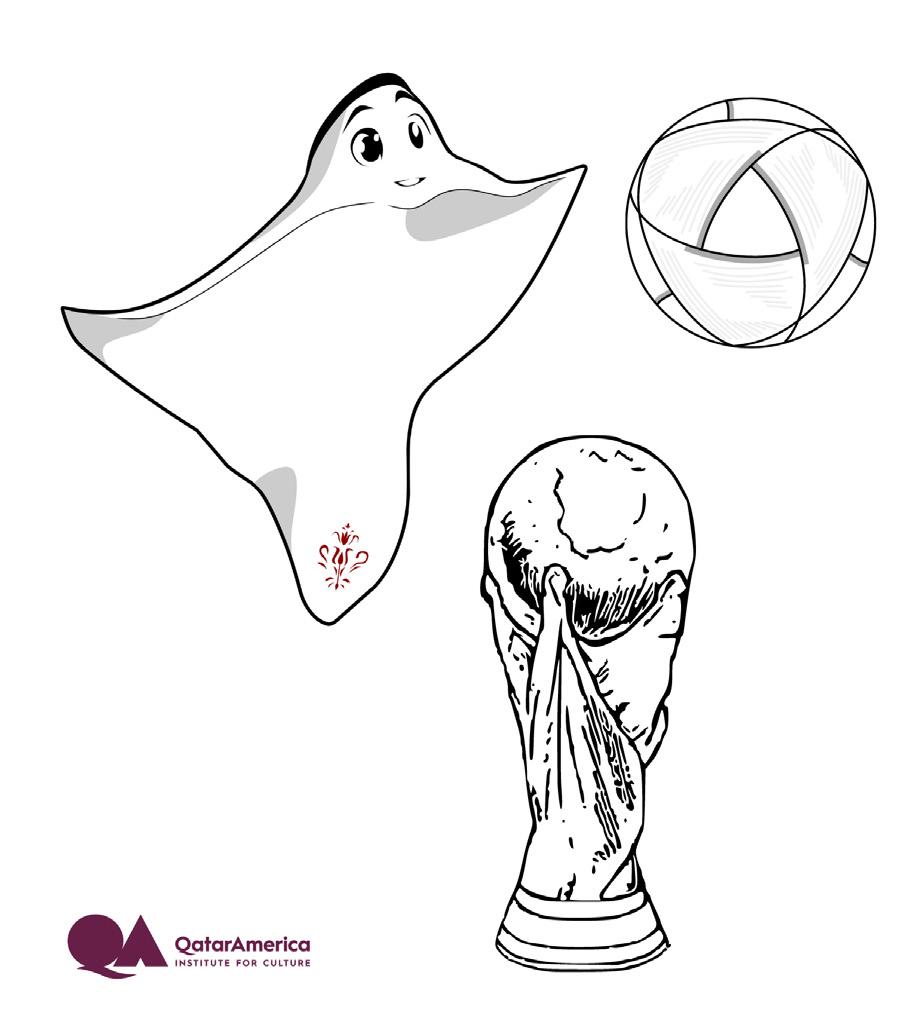





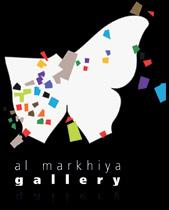

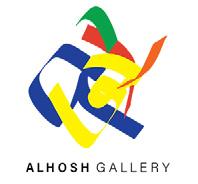

Interested in taking your support of the Qatar America Institute of Culture further? If so, you can do this in two ways: supporting QAIC’s mission and programming as an official sponsor, or joining QAIC’s membership community to enhance your art and culture journey.
As a member, you become part of the extended QAIC family. With an annual membership, you will receive more exclusive experiences during some of QAIC’s programs. These offerings include access to exclusive engagements with featured guests, intimate receptions with visiting artists, and other benefits – both tangible and intangible, to better serve you as a platform for cultural and creative enrichment. QAIC members are an extension of us; therefore, it is with this network of passionate individuals that we can further advance our mission of connecting creatives, convening communities, and celebrating cultures, locally and beyond. For more information, visit www.qataramerica.org/membership
As a sponsor, your support will directly sustain and expand the programming that QAIC has to offer to its audiences in the United States, in Qatar, and around the world. Sponsors also receive unique benefits as part of their contribution, like exclusive access to QAIC events, brand exposure, and more. For more information, visit www.qataramerica.org/ support-QAIC
Lastly, your contributions and continued support will allow QAIC to remain a viable platform and partner for creatives and artists. Through QAIC’s programming, artists and creatives are highlighted, which helps further their own success and cultivate peace among various peoples from around the world.


